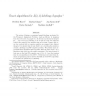117 search results - page 5 / 24 » Graphs with Chromatic Roots in the Interval (1, 2) |
APPROX
2004
Springer
14 years 23 days ago
2004
Springer
Given any integer d ≥ 3, let k be the smallest integer such that d < 2k log k. We prove that with high probability the chromatic number of a random d-regular graph is k, k + 1...
MFCS
2007
Springer
14 years 1 months ago
2007
Springer
The notion of distance constrained graph labelings, motivated by the Frequency Assignment Problem, reads as follows: A mapping from the vertex set of a graph G = (V, E) into an in...
DM
2008
13 years 7 months ago
2008
The chromatic capacity cap(G) of a graph G is the largest k for which there exists a k-coloring of the edges of G such that, for every coloring of the vertices of G with the same ...
DM
2010
13 years 7 months ago
2010
Let Mad(G) denote the maximum average degree (over all subgraphs) of G and let i(G) denote the injective chromatic number of G. We prove that if Mad(G) 5 2 , then i(G) + 1; sim...
STOC
2004
ACM
14 years 7 months ago
2004
ACM
Given d (0, ) let kd be the smallest integer k such that d < 2k log k. We prove that the chromatic number of a random graph G(n, d/n) is either kd or kd + 1 almost surely.

